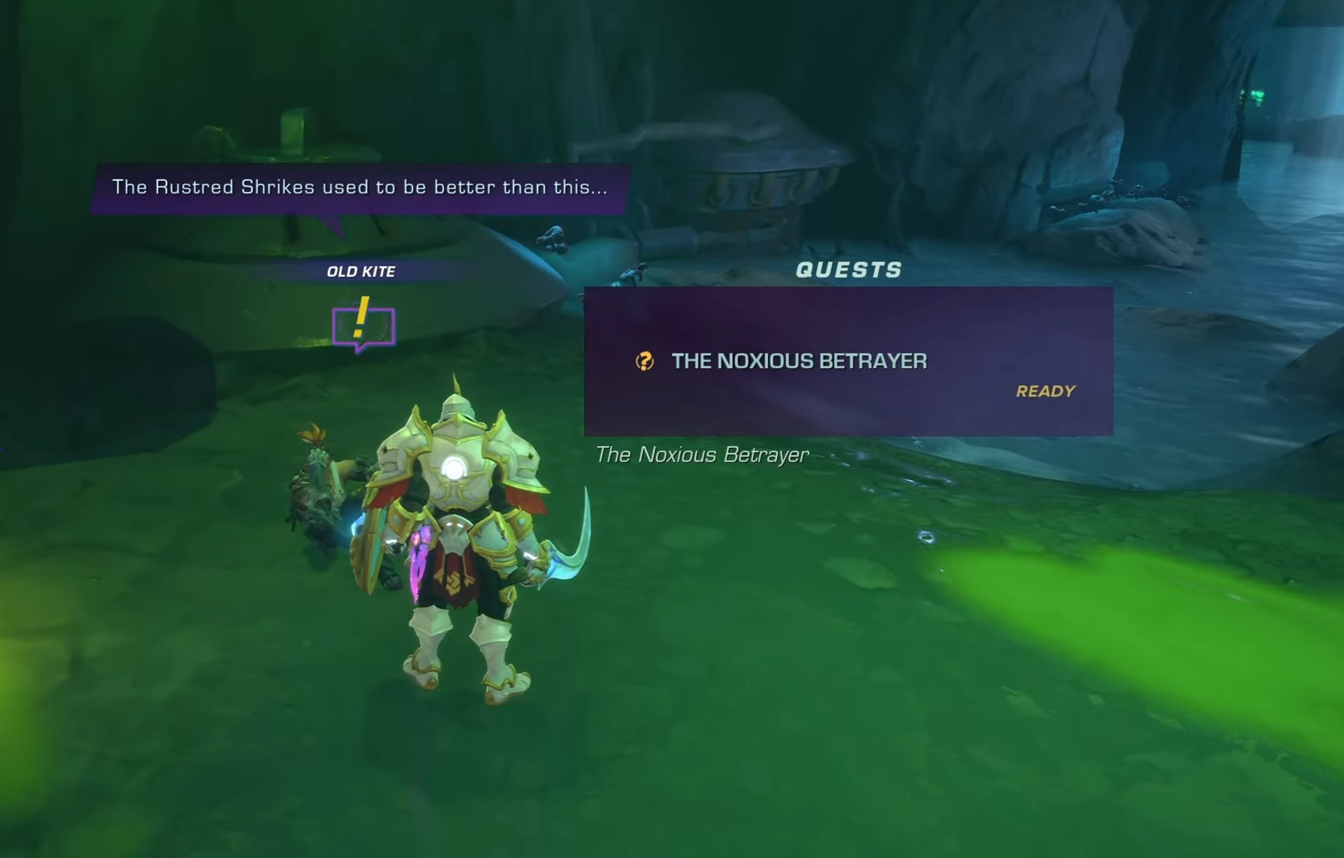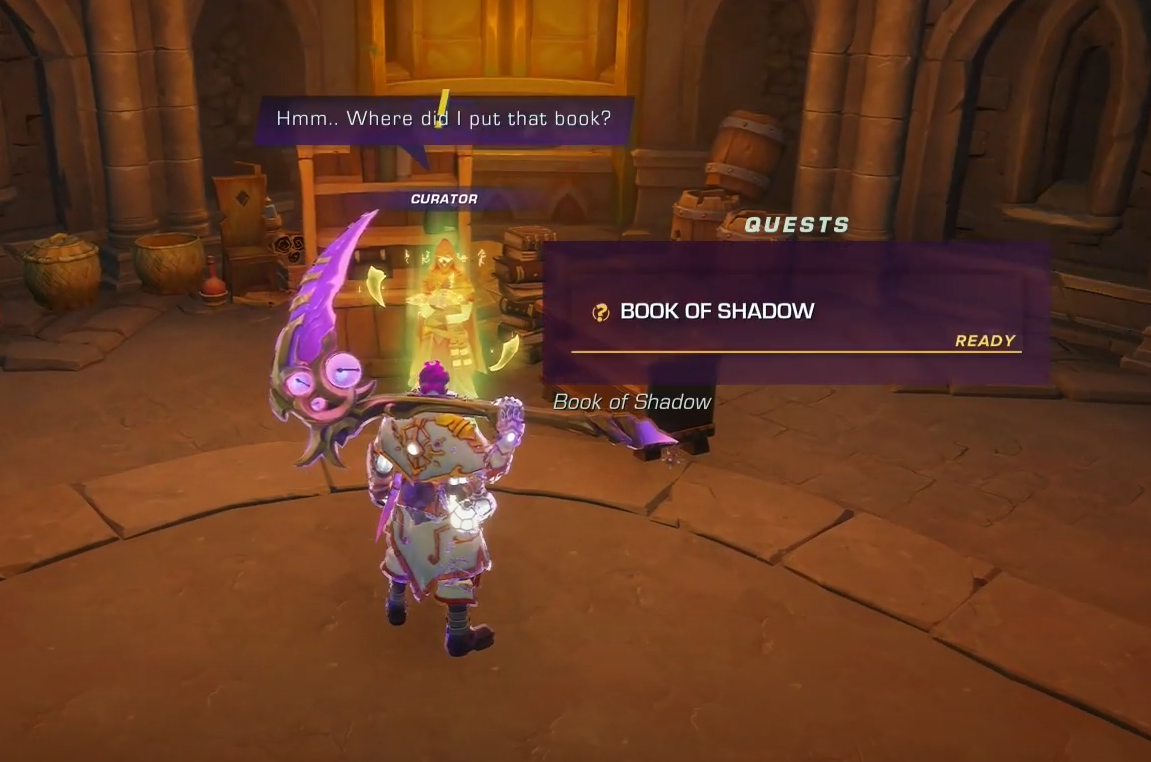Wayfinder
Wayfinder is a Live-Service, Action MMORPG game featuring fast paced Third-Person combat and randomly generated Dungeons. Wayfinders must Control the Chaos as they directly shape and customize the endless adventures with their friends.
While working on Wayfinder, I was responsible for designing, scripting, and implementing over 100 quests, including all main story quests and the new user experience. In addition, I created numerous gameplay events, often in support of these quests, using Unreal Engine Blueprints.
Role: Game Designer
Project Details:
• Studio: Airship Syndicate
• Worked on the Game for: 2+ Years
• Game Engine: Unreal Engine 4
Highlighted Contributions:
• Main Story Quests
• Gameplay Events for Quests
• New User Experience
Main Story Quests
Working on the main story quests for Wayfinder has been an inspiring experience that fueled my passion for narrative design. As a designer, my role was to translate the writer’s vision into engaging and enjoyable gameplay. Below is a video showcasing a playthrough of one of the main story quests I designed.
Making Quests:
A lot goes into creating a Main Story Quest. I begin by breaking down a section of the story, written by the writer, and mapping out a series of quest objectives to guide players from start to finish. Before diving into implementation, I will compile a list of any art assets, world building support, or engineering support I will need. Then, I prototype the quest using Unreal Engine Blueprints, kitbashing existing art assets and writing placeholder dialogue. My priority is to make the quest playable as quickly as possible, so my lead and the narrative team can provide feedback early on. As I implement their feedback, I also integrate completed work from artists, engineers, and the writer. Once a batch of main story quests is ready for wider input, we schedule studio-wide playtests to gather additional insights.
MSQ Feedback:
Main story quests, being one of the most prominent elements of the game, often receive a significant amount of feedback from the studio. To manage this responsibility, it’s crucial to stay open to different perspectives, understanding that many people will have varied opinions. While I was still an associate designer, I struggled with how to filter feedback that didn’t come directly from a lead. I wondered: Should I implement every change requested? Can I disagree with something? When should I consult with my lead? On top of that, working on a live service game in Early Access meant balancing deadlines, while also parsing through and implementing player feedback. Over time, I’ve learned that it’s not about rigidly filtering input, but rather using my best judgment to weigh feedback against the available time and resources, and deciding what changes will have the most meaningful impact and will improve the overall experience of the game.
Gameplay Events
Events in Wayfinder are puzzles, combat encounters, trials, games of chance, and narrative devices that are often randomly generated into dungeons or the open world that players complete either by themselves or in a group. I created many different events to be used in my quests.


Dungeon Events:
As part of developing the main story quests in Wayfinder, I also designed and created numerous events using Unreal Engine Blueprints. Most of these events were built to support specific questlines. For example, if a Quest required the player to find and eliminate an enemy in a Dungeon, I would set up a Combat Encounter in an empty Event Level, assign the enemy to the Combat Manager, set the Event to grant the player an “Enemy Defeated” tag when the Encounter is completed, and then set the Event to spawn only when the player is on the right Quest and Quest Objective. I also had the opportunity to work on an Event that was unrelated to Quests that ended up being cut before release. Internally, we called the Event: “Equilibrium”. In this Event, the player would attempt to balance Radiant and Shadow elements to complete the Event. Depending on the balance of the two elements, or the imbalance, players would be rewarded or met with a challenging Enemy Encounter. The Event was designed to be replayable, so players were incentivized to try to find the Event in the Dungeon again next time to obtain different rewards based on how they chose to complete the Event each time.
Dungeon Quests:
Another specific type of event I worked on in Wayfinder were ‘Dungeon NPC Events.’ Each dungeon featured a unique NPC with their own questline for players to follow. I designed these quests to encourage the use of ‘Imbuements’—elemental modifiers applied when entering a dungeon—and to incentivize players to revisit dungeons they had already explored. I was given a lot of creative freedom with these NPCs and their quests, allowing me to write the initial storylines and dialogue, as well as create custom events tailored specifically to them.
One questline focused on hunting down and eliminating the NPC’s former criminal gang who had betrayed him, while another involved saving a different NPC from turning into a monster by tracking down rare ingredients and brewing mystical potions.
New User Experience
The New User Experience is the game’s introductory level, along with a series of quests that extend beyond it, designed to teach players how to play and introduce them to the core mechanics of Wayfinder. The video below showcases gameplay of the first level of the game, the core of the New User Experience.
Tutorial Level Collaboration:
Creating this section of the game was a collaborative effort across many different professions at the studio, but the core gameplay of the experience was implemented by a Level Designer, a UI Designer, and me. My role was to create the structure for which the players will be introduced to the core mechanics and concepts of Wayfinder through Quests. When I was first brought on to work on the New User Experience, the Level Designer had already completed a first pass on the tutorial level, so I already had a level to work in. Through several meetings, we discussed which mechanics needed to be tutorialized, where to introduce them, and how to structure the experience as a quest. After creating a loose Quest skeleton of what we determined needed to be included in this Quest, I got to work implementing the Quest Objectives into the Level and it’s Level Blueprint. Some of my key contributions to this level are: Implementing doors that blocked the player’s path until Combat Encounters were completed, an NPC that grants the player one of the core features of the game, and granting the player a gameplay ability modifier that instantly granted the player their Ultimate Attack during the Boss Encounter. While we were working in the level, the UI Designer was brought in create the UI Tutorial Pop Ups that appearing in each of the Quest Objectives. The finished product is an experience that is crafted to be entertaining and engaging for players, but also teaches them how to play the game.
Iteration:
The New User Experience underwent several iterations to strike the right balance between player freedom and guided instruction. There were many mechanics and aspects of Wayfinder we needed to teach up front. In early versions, the quests were packed with tutorials and objectives that gated player progression, overwhelming them with information. During playtesting, we realized this slowed the pacing and took away from the fun, as players were forced to read through too much too quickly.
Over time, we refined the approach by focusing only on the essential tutorials in “Chapter 1” of the main story quests, while pushing many others to “Chapter 2.” Additionally, we moved several tutorial-related objectives to a new type of quest called ‘Priority Quests.’ Despite the name, these quests allowed players to learn at their own pace without blocking progress in the main story. This structure helped streamline the experience, ensuring players could enjoy the game while gradually learning its deeper mechanics.
Working on the Main Story Quests as an Associate Designer

When work on Ruined King wrapped up and I was moved over to Wayfinder, I had just been hired on full time as an Associate Designer. Wayfinder was in a stage of development where formal “Quests” did not exist. When Airship Syndicate started experimenting with the idea of adding Quests to the game, I volunteered to design those “Pseudo Quests”. When the day arrived where Wayfinder needed formal Quests to deliver the main story of the game, I found myself in a position where I could take on that responsibility. I was certainly nervous to be working on such a large part of the game as an Associate Designer, because it was a huge step up from the rest of the work I had done in the games industry professionally. If I checked in a Quest that was broken, it would prevent everyone from progressing to content that was gated behind it. Fortunately, I had the two best resources I could have asked for: Enough time to fail and a team of extremely talented Designers to learn from. Through learning from failure, guidance from my peers, and many months of hard work, I was able to improve my Quest Design and obtain confidence in my work. Eventually, I no longer had to worry about an Associate Designer working on the Main Story Quests, because I was promoted to a Mid-level Designer!